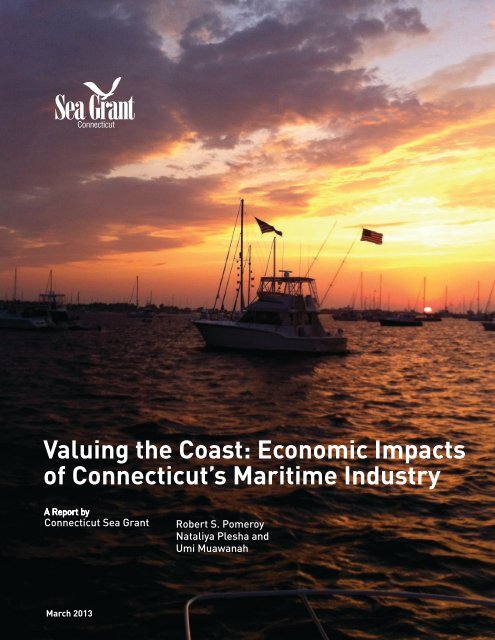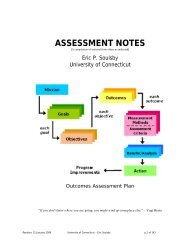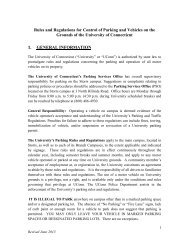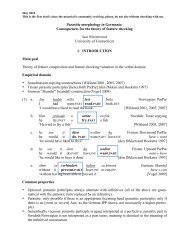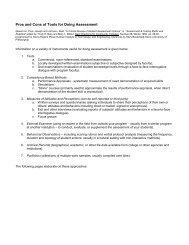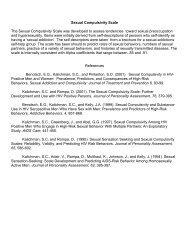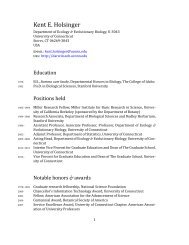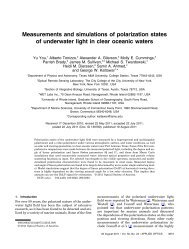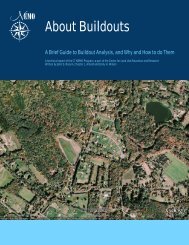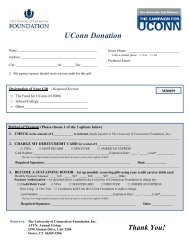Valuing the Coast: Economic Impacts of Connecticut's Maritime
Valuing the Coast: Economic Impacts of Connecticut's Maritime
Valuing the Coast: Economic Impacts of Connecticut's Maritime
Create successful ePaper yourself
Turn your PDF publications into a flip-book with our unique Google optimized e-Paper software.
Sea Grant<br />
Connecticut<br />
<strong>Valuing</strong> <strong>the</strong> <strong>Coast</strong>: <strong>Economic</strong> <strong>Impacts</strong><br />
<strong>of</strong> Connecticut’s <strong>Maritime</strong> Industry<br />
A Report by<br />
Connecticut Sea Grant<br />
Robert S. Pomeroy<br />
Nataliya Plesha and<br />
Umi Muawanah<br />
March 2013
Sea Grant is a national network comprised <strong>of</strong><br />
32 Sea Grant programs based at flagship universities in<br />
coastal and Great Lake states throughout <strong>the</strong> U.S. and<br />
Puerto Rico. The National Sea Grant College Program<br />
encourages <strong>the</strong> wise stewardship <strong>of</strong> our marine<br />
resources through research, education, outreach and<br />
technology transfer. The Program is focused on making<br />
<strong>the</strong> United States <strong>the</strong> world leader in marine research<br />
and <strong>the</strong> sustainable development <strong>of</strong> marine resources.<br />
About <strong>the</strong> authors<br />
Robert S. Pomeroy is a Pr<strong>of</strong>essor in <strong>the</strong> Department <strong>of</strong> Agricultural and Resource <strong>Economic</strong>s and Connecticut<br />
Sea Grant College Fisheries Extension Specialist at <strong>the</strong> University <strong>of</strong> Connecticut, based at Avery Point in Groton.<br />
Nataliya Plesha, PhD candidate in <strong>the</strong> Department <strong>of</strong> Agricultural and Resource <strong>Economic</strong>s, is <strong>the</strong> first<br />
recipient <strong>of</strong> <strong>the</strong> Agricultural & Applied <strong>Economic</strong>s Association Graduate Teaching Award.<br />
Umi Muawanah is a Sea Grant Knauss Fellow working at <strong>the</strong> Division <strong>of</strong> Fish and Wildlife Service in <strong>the</strong> U.S.<br />
Department <strong>of</strong> Interior.<br />
Acknowledgements<br />
Special thanks to Dr. Sylvain DeGuise, Director, Connecticut Sea Grant for supporting this project. Thank you to<br />
Dr. Rigoberto Lopez and Dr. Deepak Joglekar <strong>of</strong> <strong>the</strong> Department <strong>of</strong> Agricultural and Resource <strong>Economic</strong>s at <strong>the</strong><br />
University <strong>of</strong> Connecticut for helpful comments. We also would like to express appreciation to Susan Schadt for<br />
a creative graphic design and to Peg Van Patten for useful suggestions.<br />
CTSG – 13-06 Connecticut Sea Grant College Program<br />
2 <strong>Valuing</strong> <strong>the</strong> <strong>Coast</strong>: <strong>Economic</strong> <strong>Impacts</strong> <strong>of</strong> Connecticut’s <strong>Maritime</strong> Industry
STUDY HIGHLIGHTS<br />
Scope and Methodology<br />
The goal <strong>of</strong> this study was to ascertain and document <strong>the</strong><br />
significance <strong>of</strong> <strong>the</strong> maritime industry to Connecticut’s<br />
economy. The specific objective was to estimate <strong>the</strong> total economic<br />
impact <strong>of</strong> maritime industry sectors through <strong>the</strong> use <strong>of</strong> an economic<br />
model <strong>of</strong> <strong>the</strong> Connecticut economy. This study defines <strong>the</strong> Connecticut<br />
maritime industry as including, but not limited to, shipbuilding, commercial<br />
fishing, aquaculture, tourism, recreational boating and fishing, marine<br />
manufacturing, marine engineering, port services, marine terminal<br />
operation, marine construction, marina operation, marine environmental<br />
services, and marine transportation. Because this industry buys goods<br />
and services from o<strong>the</strong>r industries in <strong>the</strong> state and hires local labor, its<br />
economic impacts cascade throughout <strong>the</strong> entire state economy.<br />
This analysis is undertaken through selection <strong>of</strong> seven study sectors<br />
identified in <strong>the</strong> United States Department <strong>of</strong> Commerce (DOC)<br />
classification as directly related to <strong>the</strong> maritime industry in Connecticut.<br />
These included:<br />
• Commercial fishing,<br />
• Seafood product preparation and packaging,<br />
• Ship building and repairing,<br />
• Boat building,<br />
• Transport by water,<br />
• Scenic and sightseeing transportation and support activities<br />
for transportation, and<br />
• Amusement and recreation activities.<br />
Results <strong>of</strong> <strong>the</strong> Analysis<br />
For <strong>the</strong> seven sector grouping, <strong>the</strong> estimated total output impact at<br />
<strong>the</strong> state level was nearly $7 billion in 2010 (approximately $2000 per<br />
Connecticut resident). Connecticut’s maritime economy contributes<br />
nearly 40,000 jobs to <strong>the</strong> state. The total value-added impact at<br />
<strong>the</strong> state level is $4 billion. For comparison, <strong>the</strong> gross domestic<br />
product for <strong>the</strong> State <strong>of</strong> Connecticut in 2010 was $233 billion.<br />
For more information about <strong>the</strong> results reported here, visit: www.seagrant.uconn.edu<br />
3
Table <strong>of</strong> Contents<br />
Introduction page 5-7<br />
Methodology page 8-11<br />
Measure <strong>of</strong> Impact page 9-10<br />
Sector Selection page 10-11<br />
Study caveats and Limitations page 11<br />
Results and Analysis page 12-15<br />
Concluding Remarks page 16<br />
References page 17<br />
Appendix page 19-23<br />
4
<strong>Valuing</strong> <strong>the</strong> <strong>Coast</strong>:<br />
<strong>Economic</strong> <strong>Impacts</strong> <strong>of</strong> Connecticut’s <strong>Maritime</strong> Industry<br />
INTRODUCTION<br />
The goal <strong>of</strong> this study is to ascertain and document <strong>the</strong> significance<br />
<strong>of</strong> <strong>the</strong> maritime industry to Connecticut’s economy. The<br />
specific objective is to estimate <strong>the</strong> total economic impact <strong>of</strong><br />
maritime industry sectors through <strong>the</strong> use <strong>of</strong> an economic model<br />
<strong>of</strong> <strong>the</strong> Connecticut economy. This study defines <strong>the</strong> Connecticut<br />
maritime industry as including, but not limited to, shipbuilding,<br />
commercial fishing, aquaculture, tourism, recreational boating<br />
and fishing, marine manufacturing, marine engineering,<br />
port services, marine terminal operation, marine construction,<br />
marina operation, marine environmental services, and marine<br />
transportation. Because this industry buys goods and services<br />
from o<strong>the</strong>r industries in <strong>the</strong> state and hires local labor, its economic<br />
impacts cascade throughout <strong>the</strong> entire state economy.<br />
Regional economic modeling, such as input-output models,<br />
can be used to capture <strong>the</strong> economic scope <strong>of</strong> maritime industry<br />
sectors, <strong>the</strong>ir linkages to <strong>the</strong> rest <strong>of</strong> <strong>the</strong> state economy, and<br />
translate direct sales into statewide output and jobs to account<br />
for coastal industries’ purchase <strong>of</strong> goods and services from o<strong>the</strong>r<br />
industries. Results <strong>of</strong> such studies can be used for policy and<br />
economic development purposes.<br />
Connecticut’s <strong>Maritime</strong> Industry<br />
The maritime industry has always been a vital component <strong>of</strong><br />
Connecticut’s economic base and heritage. Ports and waterways<br />
support a wide range <strong>of</strong> commercial enterprises. Business<br />
sectors within this industry include shipbuilding, commercial<br />
fishing, aquaculture, marine manufacturing, marine engineering,<br />
port services, marine terminal operation, marine construction,<br />
marina operation, marine environmental services, and marine<br />
transportation. Commercial fishing exists in clusters up and<br />
down <strong>the</strong> coast and is still an important component <strong>of</strong> Connecticut’s<br />
coastal economy.<br />
5
Fairfield<br />
In addition, <strong>the</strong> waterways and shorelines provide a venue for recreation and tourism, and<br />
particularly an ever-increasing number <strong>of</strong> recreational boats and personal watercraft.<br />
<strong>Coast</strong>al Connecticut includes <strong>the</strong> four counties <strong>of</strong> New London, Fairfield, New Haven and<br />
Middlesex. The region consists <strong>of</strong> 36 towns, including several <strong>of</strong> <strong>the</strong> largest cities <strong>of</strong> <strong>the</strong><br />
state (Figure 1).<br />
New London<br />
Middlesex<br />
New Haven<br />
Figure 1. <strong>Coast</strong>al Counties <strong>of</strong> Connecticut<br />
Two past studies have examined <strong>the</strong><br />
economic impact <strong>of</strong> maritime industry<br />
sectors in Connecticut.<br />
A 1992 study, conducted by Dr. Marilyn Altobello,<br />
<strong>of</strong> <strong>the</strong> Department <strong>of</strong> Agricultural and Resource<br />
<strong>Economic</strong>s <strong>of</strong> <strong>the</strong> University <strong>of</strong> Connecticut, examined<br />
<strong>the</strong> economic importance <strong>of</strong> Long Island Sound’s (LIS)<br />
water quality-dependent activities. The study focused<br />
on Long Island Sound (including both Connecticut and<br />
New York) and estimated use values for commercial<br />
finfishing and shellfishing, recreational beach swimming,<br />
boating and sportfishing. It also estimated <strong>the</strong><br />
“multiplier effects” resulting from commercial finfishing and shellfishing and recreational<br />
activities, and coastal wetland values and intrinsic or “non-use value”. Using commercial<br />
fishing as an example, value would include <strong>the</strong> income received by a fisherman for his<br />
catch. Direct effects would include <strong>the</strong> fisherman’s expenditures for necessities associated<br />
with his business, such as boat fuel, fishing gear, ice and insurance. Indirect or<br />
multiplier effects would include wages paid to employees <strong>of</strong> fishing-related businesses<br />
and subsequently spent on goods and services by those wage earners.<br />
The total annual use-value estimates, which include commercial finfishing and<br />
shellfishing and recreational activities and intrinsic amounted to slightly<br />
6 <strong>Valuing</strong> <strong>the</strong> <strong>Coast</strong>: <strong>Economic</strong> <strong>Impacts</strong> <strong>of</strong> Connecticut’s <strong>Maritime</strong> Industry
Figure 2. Overall <strong>Economic</strong> Effect by<br />
Selected <strong>Coast</strong>al Industries <strong>of</strong> Long<br />
Island Sound (1992)<br />
Recreational<br />
fishing 19%<br />
Intrinisic<br />
values 3%<br />
Commercial fishing<br />
and shellfishing 3%<br />
over $5.5 billion in 1990, and <strong>the</strong> total economic values for<br />
wetlands were estimated at $93.75 million for 1990. It was estimated<br />
that recreational boating has <strong>the</strong> greatest overall economic effect (60%<br />
<strong>of</strong> <strong>the</strong> total LIS value), followed by recreational fishing (19%), and <strong>the</strong>n<br />
by swimming (15%) (Figure 2). Of additional, but lesser, economic<br />
importance are commercial fishing and shellfishing (3%) and<br />
1<br />
intrinsic 2 values - those that are not easily measured, including<br />
3 intangibles such as aes<strong>the</strong>tics and uncertainties such<br />
as 4 future demand (3%). The estimated use value from<br />
Connecticut<br />
5<br />
alone was $2 billion<br />
dollars in 1990.<br />
Swimming 15%<br />
Figure 3. 2010 Sales <strong>of</strong> Connecticut<br />
<strong>Coast</strong>al Industry Related Sectors<br />
O<strong>the</strong>r amusement<br />
10%<br />
Scenic and sightseeing<br />
transportation 11.9%<br />
Transport by water<br />
16.5%<br />
Commercial<br />
fishing 1.1%<br />
Recreational<br />
boating 60%<br />
Seafood<br />
product 0.6%<br />
Ship building and<br />
repairing 59.5%<br />
Boat<br />
building 0.3%<br />
In 2010, <strong>the</strong> Connecticut <strong>Maritime</strong> Coalition (CMC) commissioned<br />
a study, The <strong>Economic</strong> Impact Study <strong>of</strong> <strong>Maritime</strong> Industries in Connecticut. A<br />
consulting firm undertook <strong>the</strong> study to prepare an economic assessment <strong>of</strong><br />
Connecticut’s maritime industry sectors and its effects on <strong>the</strong> overall State’s<br />
economy. The study assessed <strong>the</strong> direct, indirect and induced economic effects<br />
<strong>of</strong> <strong>the</strong> maritime-related industries and clusters in Connecticut using a<br />
combination <strong>of</strong> telephone and in-person interviews, compilation <strong>of</strong> available<br />
and pertinent secondary source data, and application <strong>of</strong> economic modeling<br />
techniques. The study used an input-output model, called <strong>the</strong> R/ECON I-O<br />
model, developed by Rutgers University. The evaluation results provide business<br />
output (revenues), jobs, household income, value added and local/state/<br />
federal taxes associated with <strong>the</strong> maritime industries identified by <strong>the</strong> CMC as<br />
critical elements <strong>of</strong> <strong>the</strong> State’s maritime economy.<br />
The study found that in 2007, Connecticut’s maritime-dependent<br />
industries, including <strong>the</strong>ir suppliers and related economic activities<br />
(total direct, indirect and induced effects that reflect changes in local<br />
spending from income changes in <strong>the</strong> affected industry sectors),<br />
were estimated 1 to account for over $5 billion in<br />
business 2 output, generating 30,000 jobs;<br />
approximately 3 $1.7 billion in household income;<br />
and 4 $2.7 billion in Connecticut’s gross domestic<br />
product 5 (GDP). As a consequence <strong>of</strong> <strong>the</strong>se direct, indirect,<br />
and 6 induced economic effects within <strong>the</strong> statewide economy,<br />
maritime 7 industries annually account for over $56 million in<br />
taxes paid to local communities, $54 million in State tax revenues,<br />
and over $224 million in Federal tax revenues.<br />
Wages within Connecticut’s maritime-dependent industries averaged nearly<br />
$63,000 per year per job in 2007. This average wage is 15 percent higher than<br />
<strong>the</strong> average wage <strong>of</strong> $55,000 reported for all jobs in Connecticut in 2007. Ship<br />
building and repairing leads primary coastal industries; accounting for more<br />
than half <strong>of</strong> total sales (i.e., $2,039 million in 2010), followed by transport by<br />
water, scenic and sightseeing transportation, and o<strong>the</strong>r amusement and<br />
recreation industries (Figure 3). Seafood products and boat<br />
building sectors account for <strong>the</strong> smallest share in total sales in <strong>the</strong> state.<br />
<strong>Valuing</strong> <strong>the</strong> <strong>Coast</strong>: <strong>Economic</strong> <strong>Impacts</strong> <strong>of</strong> Connecticut’s <strong>Maritime</strong> Industry<br />
7
METHODOLOGY<br />
Because maritime industries purchase goods and services<br />
from o<strong>the</strong>r industries and hire local labor, its economic<br />
impact cascades throughout <strong>the</strong> state’s economy. <strong>Maritime</strong><br />
industries include such activities as fisheries, aquaculture,<br />
shipping, marinas, and tourism. Using direct sales <strong>of</strong><br />
coastal industries, this study estimates <strong>the</strong> total economic<br />
impact <strong>of</strong> maritime industries through <strong>the</strong> use <strong>of</strong> an economic<br />
model <strong>of</strong> <strong>the</strong> Connecticut economy. This input-output<br />
model will capture <strong>the</strong> scope <strong>of</strong> coastal industries, <strong>the</strong>ir<br />
linkages to <strong>the</strong> rest <strong>of</strong> <strong>the</strong> state economy, and translate<br />
direct sales into statewide output and jobs to account for<br />
maritime industries purchase <strong>of</strong> goods and services from<br />
o<strong>the</strong>r industries.<br />
In economics, an input-output model is a quantitative<br />
economic technique that represents <strong>the</strong> interdependencies<br />
between different branches <strong>of</strong> <strong>the</strong> economy (Isard 1960;<br />
Lahr and Dietzenbacher 2001; Leontif 1986; Miller and Blair<br />
2009; ten Raa 2005; US Department <strong>of</strong> Commerce 1997).<br />
Wassily Leontif developed this type <strong>of</strong> analysis. Leontif’s<br />
contribution was to state <strong>the</strong> model in such a way as to<br />
make computation feasible. He used a matrix representation<br />
<strong>of</strong> a nation’s (or a region’s) economy. His model depicts<br />
inter-industry relations <strong>of</strong> an economy. It shows how <strong>the</strong><br />
output <strong>of</strong> one industry is an input to each o<strong>the</strong>r industry.<br />
Leontief put forward <strong>the</strong> display <strong>of</strong> this information in <strong>the</strong><br />
form <strong>of</strong> a matrix. A given input is typically enumerated in<br />
<strong>the</strong> column <strong>of</strong> an industry and its outputs are enumerated<br />
in its corresponding row. This format, <strong>the</strong>refore, shows how<br />
dependent each industry is on all o<strong>the</strong>rs in <strong>the</strong> economy<br />
both as customer <strong>of</strong> <strong>the</strong>ir outputs and as supplier <strong>of</strong> <strong>the</strong>ir<br />
inputs. Each column <strong>of</strong> <strong>the</strong> input-output matrix reports<br />
<strong>the</strong> monetary value <strong>of</strong> an industry’s inputs and each row<br />
represents <strong>the</strong> value <strong>of</strong> an industry’s outputs. Because <strong>the</strong><br />
input-output model is fundamentally linear in nature, it<br />
lends itself well to rapid computation as well as flexibility in<br />
computing <strong>the</strong> effects <strong>of</strong> changes in demand. The structure<br />
<strong>of</strong> <strong>the</strong> input-output model has been incorporated into<br />
national accounting in many developed countries, and as<br />
such forms an important part <strong>of</strong> measures such as GDP (an<br />
indicator <strong>of</strong> <strong>the</strong> health <strong>of</strong> <strong>the</strong> nation’s economy). In addition<br />
to studying <strong>the</strong> structure <strong>of</strong> national economies, input-output<br />
economics has been used to study regional economies<br />
8
within a nation, and as a tool for national and<br />
regional economic planning. Indeed, a main use<br />
<strong>of</strong> input-output analysis is for measuring <strong>the</strong><br />
economic impacts <strong>of</strong> events as well as public<br />
investments or programs. But it is also used to<br />
identify economically-related industry clusters<br />
and also so-called “key” or “target” industries-<br />
-industries that are most likely to enhance <strong>the</strong><br />
internal coherence <strong>of</strong> a specified economy. By<br />
linking industrial output to satellite accounts<br />
articulating energy use, effluent production,<br />
space needs, and so on, input-output analysts<br />
have extended <strong>the</strong> application <strong>of</strong> this approach<br />
to a wide variety <strong>of</strong> uses.<br />
This study uses IMPLAN (IMpact analysis for<br />
PLANning: Minnesota IMPLAN Group, Inc.)<br />
s<strong>of</strong>tware to evaluate <strong>the</strong> economic impacts <strong>of</strong><br />
Connecticut maritime industries, aiming to<br />
capture <strong>the</strong> scope <strong>of</strong> <strong>the</strong> maritime industry, its<br />
linkages to <strong>the</strong> rest <strong>of</strong> <strong>the</strong> state economy, and to<br />
assess its contribution to statewide output and<br />
jobs. IMPLAN is a widely used model for inputoutput<br />
analysis.The IMPLAN model has recently<br />
been used to evaluate <strong>the</strong> economic impacts <strong>of</strong><br />
Connecticut’s agricultural industry (ARE 2010).<br />
IMPLAN looks at incremental impacts as a sector<br />
increases or decreases in activity via built-in<br />
multipliers based on input-output tables <strong>of</strong> <strong>the</strong><br />
economy. The IMPLAN model uses as input<br />
<strong>the</strong> direct sales from a sector or <strong>the</strong> industry<br />
and calculates economy-wide impacts through<br />
multipliers (see Table A1 <strong>of</strong> <strong>the</strong> Appendix).<br />
Generally, economic multipliers estimate <strong>the</strong><br />
economy-wide impact on related economic<br />
sectors <strong>of</strong> changes in one sector in <strong>the</strong> identified<br />
economy, such as a state, across all o<strong>the</strong>r<br />
sectors <strong>of</strong> <strong>the</strong> economy. An important feature <strong>of</strong><br />
<strong>the</strong> IMPLAN model is that it focuses on “supply”<br />
to an industry, treating <strong>the</strong> sector <strong>of</strong> interest as<br />
<strong>the</strong> point <strong>of</strong> final “demand”.<br />
Measures <strong>of</strong> <strong>Impacts</strong><br />
The IMPLAN model provides a means to capture not only <strong>the</strong> direct impact <strong>of</strong> maritime industries<br />
but also <strong>the</strong> indirect and induced impacts that occur when maritime industry’s dollars work <strong>the</strong>ir<br />
way through <strong>the</strong> economy. To be more specific, IMPLAN uses three effects to measure economic<br />
impact: direct effect, indirect effect and induced effect.<br />
• Direct effect refers to production change<br />
associated with a change in demand for<br />
<strong>the</strong> good itself. It is <strong>the</strong> initial impact to <strong>the</strong><br />
economy;<br />
• Indirect effect refers to <strong>the</strong> secondary impact<br />
caused by changing input needs <strong>of</strong> directly<br />
affected industries (i.e., additional input<br />
purchases to produce additional output); and<br />
• Induced effect is caused by changes in<br />
household spending due to <strong>the</strong> additional<br />
employment generated by direct and indirect<br />
effects.<br />
Using <strong>the</strong> IMPLAN model, <strong>the</strong> study will develop<br />
three indicators <strong>of</strong> <strong>the</strong> economic importance or<br />
impacts <strong>of</strong> maritime industries: (1) Total impact<br />
on state output, <strong>the</strong> value <strong>of</strong> which is measured<br />
by statewide sales; (2) Total impact on state<br />
employment, which includes full-time and parttime<br />
jobs generated; and (3) Total impact on<br />
value added, which measures <strong>the</strong> value added<br />
to raw materials. Although <strong>the</strong> primary focus<br />
is on <strong>the</strong> total impacts at <strong>the</strong> state level, this<br />
report also discusses impacts at <strong>the</strong> county and<br />
subsector levels.<br />
For example, <strong>the</strong> economic importance <strong>of</strong><br />
<strong>the</strong> ship building and repairing, boat building<br />
and transport by water in Connecticut is not<br />
limited to <strong>the</strong> $4,690.8 million worth <strong>of</strong> goods<br />
<strong>Valuing</strong> <strong>the</strong> <strong>Coast</strong>: <strong>Economic</strong> <strong>Impacts</strong> <strong>of</strong> Connecticut’s <strong>Maritime</strong> Industry<br />
9
and services sold by those sectors (<strong>the</strong> direct impact).<br />
Those sectors’ effect extends to o<strong>the</strong>r sectors<br />
<strong>of</strong> <strong>the</strong> economy (e.g., forestry and steel sector)<br />
because ship building, boat building and transport<br />
by water businesses buy goods and services from<br />
those o<strong>the</strong>r sectors (<strong>the</strong> indirect impact). Also,<br />
employees <strong>of</strong> <strong>the</strong> ship building and repairing, boat<br />
building and transport by water may spend a significant<br />
portion <strong>of</strong> <strong>the</strong>ir earnings buying goods and<br />
services from firms within <strong>the</strong> state (<strong>the</strong> induced<br />
impact). The total sales impact <strong>of</strong> <strong>the</strong> ship building<br />
and repairing, boat building and transport by<br />
water industries are <strong>the</strong> sum <strong>of</strong> <strong>the</strong> direct, indirect,<br />
and induced impacts. The same implies to o<strong>the</strong>r<br />
multipliers such as employment and value added<br />
impacts <strong>of</strong> <strong>the</strong> industry.<br />
Finally, it should be noted that estimated impacts<br />
are limited to Connecticut’s economy including <strong>the</strong><br />
countywide analysis. For example, if <strong>the</strong> boat building<br />
industry in Connecticut purchases parts for a<br />
vessel from a company in New York, <strong>the</strong> indirect<br />
impact <strong>of</strong> this transaction will not be felt in <strong>the</strong><br />
Connecticut economy.<br />
In addition, input-output models incorporate several<br />
assumptions that impose some limitations on<br />
<strong>the</strong> interpretation <strong>of</strong> results:<br />
• The input-output model assumes a constant<br />
production function for each firm within <strong>the</strong><br />
industry. The economies <strong>of</strong> scale are not taken<br />
into account in <strong>the</strong> input-output model. For<br />
example, it assumes that <strong>the</strong> small and <strong>the</strong><br />
large firm will use <strong>the</strong> same inputs in <strong>the</strong><br />
same proportion;<br />
• Output is assumed to be homogeneous assuming<br />
that <strong>the</strong> two firms would produce <strong>the</strong><br />
same percentage <strong>of</strong> goods and services;<br />
• Input-output model assumes that <strong>the</strong>re are no<br />
additional constraints on <strong>the</strong> supply side <strong>of</strong> any<br />
commodity.<br />
1<br />
At <strong>the</strong> present time <strong>the</strong> U.S. national income accounts contain an account for <strong>the</strong> gross output and income from housing, and<br />
it may be desirable to develop special accounts dealing with energy. Such supplementary or satellite accounts (i.e., special key<br />
sector) need not necessarily be fully articulated with o<strong>the</strong>r sector or subsector accounts. But <strong>the</strong>y should be consistent with and<br />
logically fit into <strong>the</strong> national accounting system<br />
10 <strong>Valuing</strong> <strong>the</strong> <strong>Coast</strong>: <strong>Economic</strong> <strong>Impacts</strong> <strong>of</strong> Connecticut’s <strong>Maritime</strong> Industry
Sector Selection<br />
This study uses <strong>the</strong> U.S. Department <strong>of</strong> Commerce (DOC) classification <strong>of</strong> sectors <strong>of</strong> <strong>the</strong> economy. This<br />
classification divides <strong>the</strong> economy into 440 sectors. It was agreed in advance that <strong>the</strong> primary sectors to be<br />
studied would include:<br />
• Commercial and recreational fisheries<br />
• Marine transportation and ports<br />
• Tourism<br />
• Recreational boating<br />
• Aquaculture<br />
This analysis is undertaken through selection <strong>of</strong><br />
seven sectors identified in <strong>the</strong> DOC classification as<br />
directly related to <strong>the</strong> maritime industry in Connecticut.<br />
The DOC data used in <strong>the</strong> analysis is for 2010.<br />
These included:<br />
• Commercial fishing,<br />
• Seafood product preparation and packaging,<br />
• Ship building and repairing,<br />
• Boat building,<br />
• Transport by water,<br />
• Scenic and sightseeing transportation and<br />
support activities for transportation, and<br />
• Amusement and recreation activities.<br />
However, this study does not specifically include<br />
aquaculture which plays an important part in <strong>the</strong><br />
economy <strong>of</strong> Connecticut’s coastal region.<br />
The aquaculture sector is classified in <strong>the</strong> DOC classification<br />
as a sub-sector <strong>of</strong> <strong>the</strong> agriculture sector,<br />
and data is not separated from agriculture as a<br />
whole (IMPLAN, 2010). The Connecticut agriculture<br />
industry provides approximately 20,000 jobs<br />
statewide and $3.5 billion in output (Department<br />
<strong>of</strong> Agricultural and Resource <strong>Economic</strong>s, 2010).<br />
Aquaculture is a relatively small portion <strong>of</strong> <strong>the</strong> total<br />
agriculture sector in <strong>the</strong> state and thus including<br />
<strong>the</strong> whole agriculture sector would not provide a<br />
true indication <strong>of</strong> <strong>the</strong> impact <strong>of</strong> aquaculture on <strong>the</strong><br />
economy. According to <strong>the</strong> Connecticut Department<br />
<strong>of</strong> Agriculture, Bureau <strong>of</strong> Aquaculture, <strong>the</strong> Connecticut<br />
shellfishing industry provides more than 300 jobs<br />
statewide and generates $30 million plus in farmgate<br />
sales annually.<br />
The study is undertaken at three scales:<br />
• Statewide<br />
• <strong>Coast</strong>al region (four counties)<br />
• Individual county (New London, Fairfield, New<br />
Haven and Middlesex)<br />
Study Caveats and Limitations<br />
This is a preliminary analysis <strong>of</strong> <strong>the</strong> economic value<br />
<strong>of</strong> <strong>the</strong> maritime economy <strong>of</strong> Connecticut. The study<br />
will be limited to <strong>the</strong> market value <strong>of</strong> <strong>the</strong> maritime<br />
economy relying on secondary data provided by <strong>the</strong><br />
U.S. Department <strong>of</strong> Commerce. It should be noted<br />
that <strong>the</strong> estimated impacts are limited to Connecticut’s<br />
economy.<br />
This study does not analyze <strong>the</strong> non-market value <strong>of</strong><br />
ecosystem services provided by natural resources <strong>of</strong><br />
<strong>the</strong> Connecticut coast. Ecosystem services (ecological<br />
services) are economic benefits provided<br />
to society by nature such as water filtration, flood<br />
reduction, and drinking water supply. Nor does<br />
<strong>the</strong> study estimate <strong>the</strong> market value <strong>of</strong> natural<br />
resources (<strong>the</strong> value <strong>of</strong> ecosystem services) <strong>of</strong> <strong>the</strong><br />
Connecticut coast for habitat such as wetlands and<br />
marine waters. Also excluded are <strong>the</strong> scenic views<br />
and social benefits from <strong>the</strong> estimation that result<br />
from such maritime industries as tourism, shipping<br />
and fishing. These non-market benefits that are not<br />
measured by market earnings are equally important<br />
when one measures economic benefits <strong>of</strong> <strong>the</strong><br />
industry. However, this will require more resources<br />
than are currently available and some primary data<br />
collection. The current study will serve as a foundation<br />
for <strong>the</strong>se additional analyses.<br />
<strong>Valuing</strong> <strong>the</strong> <strong>Coast</strong>: <strong>Economic</strong> <strong>Impacts</strong> <strong>of</strong> Connecticut’s <strong>Maritime</strong> Industry 11
Results and Analysis<br />
for <strong>the</strong> Seven Core <strong>Maritime</strong> Sectors<br />
Total Output <strong>Impacts</strong><br />
The total output impact <strong>of</strong> maritime industries<br />
from seven core maritime sectors is presented in<br />
Figure 4 using state level and four coastal counties<br />
data for 2010. The state level and four coastal<br />
counties output impacts are $6.83 and $5.88<br />
billion, respectively. For <strong>the</strong>se seven sectors, <strong>the</strong><br />
total four coastal counties output impact<br />
comprises almost 86 percent <strong>of</strong> <strong>the</strong> total state<br />
impacts. Total output impact <strong>of</strong> <strong>the</strong>se sectors<br />
at <strong>the</strong> county level are $3,300, $1,366, $522.5,<br />
and $87.9 million for New London, Fairfield, New<br />
Haven and Middlesex County, respectively. Figure 4<br />
shows that New London County has a little less than<br />
50 percent <strong>of</strong> <strong>the</strong> total state output impacts. These<br />
estimated output impacts are significantly higher<br />
than <strong>the</strong> $2 billion figure from <strong>the</strong> previous<br />
study by Altobello (1992). For comparison, <strong>the</strong><br />
gross domestic product for <strong>the</strong> state <strong>of</strong><br />
Connecticut in 2010 was $233 billion (U.S.<br />
Bureau <strong>of</strong> <strong>Economic</strong> Analysis 2011).<br />
12
Figure 4. Total output impact (influence <strong>of</strong> <strong>the</strong> economic sectors on <strong>the</strong> total <strong>of</strong> all<br />
state sales revenue in all sectors <strong>of</strong> <strong>the</strong> coastal economy) in 2010.<br />
Detailed information on output impact for each <strong>of</strong> <strong>the</strong> seven selected sectors is shown in Table 1 for<br />
Connecticut, four counties, and each individual county. For Connecticut, ship building (for commercial<br />
and military purposes) is <strong>the</strong> sector contributing <strong>the</strong> most to <strong>the</strong> economy among <strong>the</strong> seven sectors. It<br />
is <strong>the</strong> same for <strong>the</strong> four counties, as well as New London County. However, for <strong>the</strong> o<strong>the</strong>r three counties,<br />
<strong>the</strong> most important sector contributing to <strong>the</strong> economy is transport by water for Fairfield; scenic and<br />
sightseeing transportation and support activities for transportation for New Haven; and o<strong>the</strong>r amusement<br />
and recreation industries for Middlesex.<br />
Table 1. Total output impact by sector in 2010 million dollars<br />
Sector CT state Four Counties New London Fairfield New Haven Middlesex<br />
Commercial Fishing 65.1 63.9 15.8 9.2 23.4 12.5<br />
Seafood product preparation and packaging 45.1 35.4 0.8 23.1 10.9 0.0<br />
Ship building and repairing 3,664.6 3,519.2 2,982.4 0.0 1.3 0.0<br />
Boat building 17.1 15.3 0.2 14.3 0.2 0.1<br />
Transport by water 1,009.1 904.6 193.6 524.7 150.9 5.8<br />
Scenic and sightseeing transportation and<br />
support activities for transportation 1,177.4 772.2 47.1 463.1 229.7 12.9<br />
O<strong>the</strong>r amusement and recreation industries 853.2 574.3 60.3 332.4 105.9 56.6<br />
<strong>Valuing</strong> <strong>the</strong> <strong>Coast</strong>: <strong>Economic</strong> <strong>Impacts</strong> <strong>of</strong> Connecticut’s <strong>Maritime</strong> Industry<br />
1 3
Total Employment Impact<br />
Figure 5. Total maritime employment impact (full and part time jobs generated)<br />
on core (7) coastal sectors<br />
Table 2. Total employment impact (maritime jobs generated) by sector in 2010<br />
Sector CT state Four counties New London Fairfield New Haven Middlesex<br />
Commercial Fishing 820.6 811.9 184.8 69 338.2 212.3<br />
Seafood product preparation and packaging 216.3 168.9 4.1 95.7 57.5 0<br />
Ship building and repairing 17,607.1 16,724.2 14,434.4 0 6.6 0<br />
Boat building 86.4 76.1 0.9 68.3 1.2 0.6<br />
Transport by water 3,692.9 3,182.9 671 1,718.0 575.4 19.5<br />
Scenic and sightseeing transportation and<br />
support activities for transportation 8,169.9 5,052.9 404.1 2,635.1 1,750.0 118.4<br />
O<strong>the</strong>r amusement and recreation industries 9,253.2 6,089.1 671.9 3,375.2 1,332.1 573.8<br />
14 <strong>Valuing</strong> <strong>the</strong> <strong>Coast</strong>: <strong>Economic</strong> <strong>Impacts</strong> <strong>of</strong> Connecticut’s <strong>Maritime</strong> Industry
The total employment impact <strong>of</strong> maritime industries for <strong>the</strong> seven<br />
core sectors is presented in Figure 5 using State level and four<br />
coastal counties data for 2010. It exhibits a similar trend to total<br />
output impact with New London employment impact reaching<br />
about 75 percent <strong>of</strong> state level total employment impact. This<br />
study shows that Connecticut’s maritime related industry is an<br />
important contributor to employment in <strong>the</strong> state. The state level<br />
and four-coastal counties total employment impacts are 39,846<br />
and 32,106 jobs, respectively. For <strong>the</strong>se chosen sectors, total four<br />
coastal counties employment impact comprises almost 86 percent<br />
<strong>of</strong> <strong>the</strong> total state impact. Total employment impacts for <strong>the</strong>se<br />
sectors at county levels are 16,371, 7,961, 4,061, and 924 jobs for<br />
New London, Fairfield, New Haven and Middlesex County, respectively.<br />
Figure 5 shows that New London County has about 40 % <strong>of</strong><br />
state employment impact. For comparison, <strong>the</strong>re were 1,594,700<br />
jobs in Connecticut in 2010 according to <strong>the</strong> Bureau <strong>of</strong> <strong>Economic</strong><br />
Analysis (2011).<br />
Total employment impact for each <strong>of</strong> <strong>the</strong> seven selected sectors<br />
is presented in Table 2 for Connecticut, four counties, and each<br />
county. Ship building is <strong>the</strong> sector contributing <strong>the</strong> most employment<br />
to <strong>the</strong> Connecticut economy among <strong>the</strong> seven sectors. It is<br />
<strong>the</strong> same for <strong>the</strong> four counties as well as New London County.<br />
However, for <strong>the</strong> o<strong>the</strong>r three counties, <strong>the</strong> most important sector<br />
contributing to employment is transport by water for Fairfield;<br />
scenic and sightseeing transportation and support activities for<br />
transportation for New Haven; and o<strong>the</strong>r amusement and<br />
recreation industries for Middlesex.<br />
<strong>Valuing</strong> <strong>the</strong> <strong>Coast</strong>: <strong>Economic</strong> <strong>Impacts</strong> <strong>of</strong> Connecticut’s <strong>Maritime</strong> Industry<br />
1 5
Total Value Added Impact<br />
Value added impact is defined as <strong>the</strong> sum <strong>of</strong> salaries and wages earned by all<br />
workers in <strong>the</strong> state, income received by self-employed individuals, payments<br />
received by individuals and corporations in <strong>the</strong> form <strong>of</strong> interest, rents, royalties,<br />
dividends, and pr<strong>of</strong>it, and indirect business taxes paid by individuals to businesses<br />
(IMPLAN, 2004). This is an important measure <strong>of</strong> <strong>the</strong> impact <strong>of</strong> an economic sector.<br />
Hence, much <strong>of</strong> <strong>the</strong> value added by an economic activity, such as <strong>the</strong> maritime<br />
industry sectors, in a state is presented as money earned by <strong>the</strong> residents <strong>of</strong> <strong>the</strong><br />
state, which <strong>the</strong>y can <strong>the</strong>n spend buying goods and services, inducing fur<strong>the</strong>r<br />
economic activity in <strong>the</strong> state.<br />
The total value added impact from <strong>the</strong> seven selected maritime sectors is<br />
presented in Figure 6. For state level and combined four counties, <strong>the</strong> total<br />
added value impact is $4,017.5 million and $3,456 million, respectively.<br />
Total added value impacts for <strong>the</strong> four individual counties are $1750. 9,<br />
$896.4, $305.3 and $54.11 million for New London, Fairfield, New Haven,<br />
and Middlesex, respectively. The four counties total added value impact is almost<br />
86 percent <strong>of</strong> total state level impact for <strong>the</strong> seven sectors. This implies that <strong>the</strong>se<br />
seven sectors are major contributors to <strong>the</strong> state economy.<br />
Figure 6. Total Value Added impact on core coastal sectors (salaries, wages, and<br />
o<strong>the</strong>r income added by an economic activity). Data is from <strong>the</strong> year 2010.<br />
16 <strong>Valuing</strong> <strong>the</strong> <strong>Coast</strong>: <strong>Economic</strong> <strong>Impacts</strong> <strong>of</strong> Connecticut’s <strong>Maritime</strong> Industry
Concluding Remarks<br />
The goal <strong>of</strong> this study is to ascertain and document<br />
<strong>the</strong> significance <strong>of</strong> <strong>the</strong> maritime industry to<br />
Connecticut’s economy. The specific objective is<br />
to estimate <strong>the</strong> total economic impact <strong>of</strong> maritime<br />
industries through <strong>the</strong> use <strong>of</strong> an economic model<br />
<strong>of</strong> <strong>the</strong> Connecticut economy. This study defines <strong>the</strong><br />
Connecticut maritime industry as including, but not<br />
limited to, shipbuilding, commercial fishing, aquaculture,<br />
tourism, recreational boating and fishing,<br />
marine manufacturing, marine engineering, port<br />
services, marine terminal operation, marine construction,<br />
marina operation, marine environmental<br />
services, and marine transportation. Because<br />
this industry buys goods and services from o<strong>the</strong>r<br />
industries in <strong>the</strong> state and hires local labor, its<br />
economic impacts cascade throughout <strong>the</strong> entire<br />
state economy.<br />
This analysis is undertaken through selection <strong>of</strong><br />
seven study sectors identified in <strong>the</strong> USDC classification<br />
as directly related to <strong>the</strong> maritime industry.<br />
These included:<br />
• Commercial fishing,<br />
• Seafood product preparation and packaging,<br />
• Ship building and repairing,<br />
• Boat building,<br />
• Transport by water,<br />
• Scenic and sightseeing transportation and<br />
support activities for transportation, and<br />
• Amusement and recreation activities.<br />
For <strong>the</strong> seven sector grouping, <strong>the</strong> estimated total<br />
output impact at <strong>the</strong> state level is $6.83 billion. The<br />
total employment impact at <strong>the</strong> state level is 39,846<br />
jobs. The total added value impact at <strong>the</strong> state level<br />
is $4 billion. This compares to an estimated gross<br />
domestic product <strong>of</strong> $233 billion and 1,594,700 jobs<br />
in Connecticut in 2010.<br />
For comparison, <strong>the</strong> Connecticut <strong>Maritime</strong> Coalition<br />
(CMC) commissioned study, The <strong>Economic</strong><br />
Impact Study <strong>of</strong> <strong>Maritime</strong> Industries in Connecticut,<br />
found that in 2007, Connecticut’s maritimedependent<br />
industries, including <strong>the</strong>ir suppliers and<br />
related economic activities (total direct, indirect<br />
and induced effects), were estimated to account<br />
for over $5 billion in business output, generating<br />
30,000 jobs.<br />
Since both studies utilized slightly different methods,<br />
<strong>the</strong> results are not exactly similar but are comparable<br />
and highlight <strong>the</strong> economic importance <strong>of</strong><br />
<strong>the</strong> maritime industry to Connecticut’s economy.<br />
<strong>Valuing</strong> <strong>the</strong> <strong>Coast</strong>: <strong>Economic</strong> <strong>Impacts</strong> <strong>of</strong> Connecticut’s <strong>Maritime</strong> Industry<br />
1 7
References<br />
Altobello, M. 1992 The <strong>Economic</strong> Importance <strong>of</strong> Long Island Sound’s Water Quality Dependent<br />
Activities. University <strong>of</strong> Connecticut, (unpublished report on file with LISS). 41 pp.<br />
Bureau <strong>of</strong> <strong>Economic</strong> Analysis. 2011. U.S. <strong>Economic</strong> Accounts. U.S. Department <strong>of</strong> Commerce,<br />
Washington D.C. www.bea.gov<br />
Connecticut Department <strong>of</strong> Agriculture, Bureau <strong>of</strong> Aquaculture web site.<br />
http://www.ct.gov/doag/cwp/view.asp?a=3768&q=458588<br />
Connecticut <strong>Maritime</strong> Coalition Inc. 2010. <strong>Economic</strong> Impact Study <strong>of</strong> <strong>Maritime</strong> Industries in<br />
Connecticut. Apex Companies LLC and FXM Associates. 136 pp.<br />
Department <strong>of</strong> Agricultural and Resource <strong>Economic</strong>s. 2010. <strong>Economic</strong> <strong>Impacts</strong> <strong>of</strong><br />
Connecticut’s Agricultural Industry, University <strong>of</strong> Connecticut. 28 pp.<br />
IMPLAN. 2004. User’s, analysis, and data guides. IMPLAN Pr<strong>of</strong>essional Version 2.0.<br />
Minnesota IMPLAN Group, Inc. 414 pp.<br />
Isard, Walter et al. 1960. Methods <strong>of</strong> Regional Analysis: An Introduction to Regional Science.<br />
MIT Press. 784 pp.<br />
Lahr, Michael L. and Erik Dietzenbacher, eds. 2001.Input-Output Analysis: Frontiers and<br />
Extensions. Palgrave. 503 pp.<br />
Leontief, Wassily W. Input-Output <strong>Economic</strong>s. 2nd ed. 1986. New York: Oxford University<br />
Press. 448 pp.<br />
Miller, Ronald E. and Peter D. Blair. 2009. Input-Output Analysis: Foundations and Extensions,<br />
2nd edition. Cambridge University Press,.781 pp.<br />
Ten Raa, Thijs. 2005. The <strong>Economic</strong>s <strong>of</strong> Input-Output Analysis. Cambridge University Press,.<br />
212 pp.<br />
US Department <strong>of</strong> Commerce, Bureau <strong>of</strong> <strong>Economic</strong> Analysis 1997. Regional multipliers: A user<br />
handbook for regional input-output modeling system (RIMS II). Third edition.<br />
Washington, D.C.: U.S. Government Printing Office. 62 pp.<br />
18 <strong>Valuing</strong> <strong>the</strong> <strong>Coast</strong>: <strong>Economic</strong> <strong>Impacts</strong> <strong>of</strong> Connecticut’s <strong>Maritime</strong> Industry
AppendiX<br />
Table A1: 2010 Data and Multipliers for <strong>the</strong> Connecticut <strong>Maritime</strong> Industry<br />
Direct Sales ($2010 million)<br />
Sector<br />
CT<br />
Four<br />
Counties<br />
NL FF NH MS<br />
Commercial Fishing 37.9 37.9 10.5 5.5 13.7 8.0<br />
Seafood product preparation and packaging 26.4 21.1 0.5 14.0 6.5 -<br />
Ship building and repairing 2,039.4 2,039.4 2,038.6 .- .07 -<br />
Boat building 10.0 9.3 0.1 9.0 0.1 0.08<br />
Transport by water 606.1 565.2 134.1 329.3 97.6 4.1<br />
Scenic and sightseeing transporation<br />
and Support activities for transporation 597.2 410.8 28.1 254.5 120.2 7.8<br />
O<strong>the</strong>r ammusement and<br />
recreation industris 494.5 343.9 40.9 201.0 64.8 37.0<br />
Direct Employment (Number <strong>of</strong> jobs)<br />
Sector<br />
CT<br />
Four<br />
Counties<br />
NL FF NH MS<br />
Commercial Fishing 653.6 653.4 146.7 47.1 274.5 185.0<br />
Seafood product preparation and packaging 76.2 60.7 1.6 40.3 18.7 -<br />
Ship building and repairing 7,685.8 7,685.8 7.6 - 2.7 -<br />
Boat building 45.5 41.9 0.5 40.3 0.7 .03<br />
Transport by water 1,078.5 992.5 234.6 557.2 193.3 7.3<br />
Scenic and sightseeing transporation<br />
and Support activities for transporation 4,212.6 2,594.9 262.3 1,331.6 919.8 81.0<br />
O<strong>the</strong>r ammusement and<br />
recreation industris 7,248.1 4,787.7 548.2 2,718.8 1,074.7 445.8<br />
CT- Connecticut<br />
NL - New London<br />
FF - Fairfield<br />
NH - New Haven<br />
MS - Middlesex<br />
<strong>Valuing</strong> <strong>the</strong> <strong>Coast</strong>: <strong>Economic</strong> <strong>Impacts</strong> <strong>of</strong> Connecticut’s <strong>Maritime</strong> Industry<br />
1 9
AppendiX<br />
Sector<br />
Commercial fishing<br />
Description<br />
Anchovy fishing; bluefish fishing; cod catching; cod fishing;<br />
croaker fishing; dolphin fishing; eel fishing; finfish fishing (e.g.,<br />
flounder, salmon, trout); fisheries, finfish; grouper fishing; haddock<br />
fishing; hake fishing; halibut fishing; lingcod fishing; mackerel<br />
fishing; mahimahi fishing; menhaden fishing; mullet fishing;<br />
perch fishing; pilchard fishing; pollock fishing; porgy fishing; ray<br />
fishing; rockfish fishing; sablefish fishing; salmon fishing; sea<br />
bass fishing; sea herring fishing; sea trout fishing; shark fishing;<br />
snapper fishing; swordfish fishing; tilefish fishing; trout fishing;<br />
tuna fishing; whiting fishing; clam digging; crabbing; crayfish<br />
fishing; fisheries, shellfish; lobster fishing; mussel fishing; octopus<br />
fishing; oyster dredging; scallop fishing; sea urchin fishing;<br />
shellfish fishing (e.g., clam, crab, oyster, shrimp); shrimp fishing;<br />
squid fishing; frog fishing; o<strong>the</strong>r marine fishing; seaweed ga<strong>the</strong>ring;<br />
sponge ga<strong>the</strong>ring; terrapin fishing; turtle fishing<br />
Seafood product<br />
preparation and<br />
packaging<br />
Cannery, fish; cannery, shellfish; canning, fish, crustacean, and<br />
mollusks; chowders, fish and seafood, canning; cod liver oil<br />
extraction, crude, produced in a cannery; curing fish and seafood;<br />
drying fish and seafood; fish and marine animal oils produced<br />
in a cannery; fish and seafood chowder canning; fish egg bait<br />
canning; fish meal produced in a cannery; fish, canned and<br />
cured, manufacturing; fish, curing, drying, pickling, salting, and<br />
smoking; floating factory ships seafood processing; seafood and<br />
seafood products canning; seafood and seafood products curing;<br />
seaweed processing (e.g., dulse); shellfish and shellfish products<br />
canning; shellfish curing; soups, fish and seafood, canning;<br />
surimi caning; chowders, frozen fish and seafood, manufacturing;<br />
cod liver oil extraction, crude, produced in a fresh and frozen<br />
seafood plant; dinners, frozen seafood, manufacturing; fish and<br />
marine animal oils produced in a fresh and frozen seafood plant;<br />
fish freezing (e.g., blocks, fillets, ready-to-serve products); fish<br />
meal produced in a fresh and frozen seafood plant; fish, fresh<br />
or frozen, manufacturing; fish, fresh prepared, manufacturing;<br />
freezing fish (e.g., blocks, fillets, ready-to-serve products); fresh<br />
and frozen seafood processing; picking crab meat; seafood dinners,<br />
frozen, manufacturing; seafood products, fresh prepared,<br />
manufacturing; seafood products, frozen, manufacturing; seafood,<br />
fresh prepared, manufacturing; seafood, frozen, manufacturing;<br />
shellfish products, fresh prepared, manufacturing; shellfish<br />
products, frozen, manufacturing; shellfish, fresh prepared,<br />
manufacturing; shellfish, frozen, manufacturing; shucking and<br />
lacking fresh shellfish; soups, frozen fish and shellfish, manufacturing;<br />
surimi, fresh and frozen, manufacturing<br />
20 <strong>Valuing</strong> <strong>the</strong> <strong>Coast</strong>: <strong>Economic</strong> <strong>Impacts</strong> <strong>of</strong> Connecticut’s <strong>Maritime</strong> Industry
AppendiX<br />
Sector<br />
Ship building and<br />
repairing<br />
Description<br />
Barge building; cargo ship building; container ship building; dredge<br />
building; drilling and production platforms, floating, oil and gas,<br />
building; drydock, floating, building; ferryboat building; fireboat<br />
building; fishing boat, commercial, building; hydr<strong>of</strong>oil vessel<br />
building and repairing in shipyard; naval ship building; oil and gas<br />
<strong>of</strong>fshore floating platforms manufacturing; passenger ship building;<br />
patrol boat building; sailing ships, commercial, manufacturing;<br />
ship dismantling at shipyards; ship repair done in a shipyard;<br />
ship scaling services done at a shipyard; ships (i.e., not suitable or<br />
intended for personal use) manufacturing; shipyard (i.e., facility<br />
capable <strong>of</strong> building ships); submarine building; towboat building<br />
and repeating; tugboat building; yachts built in shipyards<br />
Boat building<br />
Air boat building; boat yards; (i.e., boat manufacturing facilities);<br />
boats (i.e., suitable or intended for personal use) manufacturing;<br />
cabin cruiser; dinghy (except inflatable rubber) manufacturing; dories<br />
building; hovercraft building; motorboat, inboard or outboard,<br />
building; pleasure boats manufacturing; rowboats manufacturing;<br />
sailboat building, not done in shipyards; yacht building, not done<br />
in shipyards; boats, inflatable plastics, manufacturing; life rafts,<br />
inflatable plastics manufacturing; dinghies, inflatable rubber, manufacturing;<br />
life rafts inflatable rubberized fabric, manufacturing;<br />
rafts, rubber inflatable, manufacturing; boats, inflatable plastics<br />
(except toy-type), manufacturing; inflatable plastic boats, heavyduty,<br />
manufacturing; inflatable rubber boats, heavy-duty, manufacturing;<br />
rigid inflatable boats (RIBs) manufacturing; underwater<br />
remotely operated vehicles (ROVs) manufacturing; boats, inflatable<br />
plastics (except toy-type) , manufacturing; inflatable plastic boats,<br />
heavy-duty, manufacturing; inflatable rubber boats, heavy-duty,<br />
manufacturing; rigid inflatable boats (RIBs) manufacturing; underwater<br />
remotely operated vehicles (ROVs) manufacturing; boats, inflatable<br />
plastics (except toy-type) manufacturing; inflatable plastic<br />
boats, heavy-duty, manufacturing; inflatable rubber boats, heavyduty,<br />
manufacturing; rigid inflatable boats (RIBs) manufacturing;<br />
underwater remotely operated vehicles (ROVs) manufacturing<br />
Transport by water<br />
Water transportation; deep sea, coastal, and Great Lakes water<br />
transportation; deep sea freight transportation to or from foreign<br />
ports; freight transportation , deep sea, to or from foreign ports;<br />
ship chartering with crew, deep sea freight transportation to or<br />
from foreign ports; shipping freight to or from foreign ports deep<br />
sea; transporting freight to or from foreign ports, deep sea; cruise<br />
lines (i.e., deep sea passenger transportation to or from foreign<br />
ports); deep sea passenger transportation to or from foreign ports;<br />
<strong>Valuing</strong> <strong>the</strong> <strong>Coast</strong>: <strong>Economic</strong> <strong>Impacts</strong> <strong>of</strong> Connecticut’s <strong>Maritime</strong> Industry<br />
2 1
AppendiX<br />
Sector<br />
Transport by water<br />
Description<br />
passenger transportation, deep sea, to or from foreign ports; ship<br />
chartering with crew, deep sea passenger transportation to or from<br />
foreign ports; transporting passengers to or from foreign ports,<br />
deep sea; barge transportation, coastal or great Lakes (including<br />
St. Lawrence Seaway); coastal freight transportation to and from<br />
domestic ports; coastal shipping <strong>of</strong> freight to and from domestic<br />
ports; deep sea freight transportation to or from domestic ports<br />
(including Puerto Rico); freight shipping on <strong>the</strong> Great Lakes system<br />
(including St. Lawrence Seaway); freight transportation, deep sea,<br />
to and from domestic ports; Great Lakes freight transportation<br />
(including St. Lawrence seaway); intercoastal freight transportation<br />
to and from domestic ports; lake freight transportation, Great<br />
Lakes (including St. Lawrence Seaway); ship chartering with crew,<br />
coastal or Great Lakes freight transportation (including St. Lawrence<br />
Seaway); shipping freight to and from domestic ports (i.e., coastal,<br />
deep sea (including Puerto Rico), Great Lakes system (including St.<br />
Lawrence Seaway); coastal passenger transportation to and from<br />
domestic ports; cruise lines (i.e., deep sea passenger transportation<br />
to and from domestic ports, including Puerto Rico); deep sea passenger<br />
transportation to and from domestic ports (including Puerto<br />
Rico); ferry passenger transportation, Great Lakes (including St.<br />
Lawrence Seaway); Great Lakes passenger transportation (including<br />
St. Lawrence Seaway); intercoastal transportation <strong>of</strong> passengers<br />
to and from domestic ports; lake passenger transportation, Great<br />
Lakes (including St. Lawrence Seaway); passenger transportation,<br />
coastal or Great Lakes (including St. Lawrence Seaway); passenger<br />
transportation deep sea, to and from domestic ports (including<br />
Puerto Rico); ship chartering with crew, coastal or Great Lakes<br />
passenger transportation (including St. Lawrence Seaway); inland<br />
water transportation; barge transportation, canal (freight); canal<br />
barge transportation (freight); freight transportation inland waters<br />
(except on Great Lakes system); inland water freight transportation;<br />
intercoastal transportation <strong>of</strong> freight; lake freight transportation<br />
(except on Great Lakes system); lighterage (i.e., freight transportation<br />
except vessel supply services); river freight transportation; ship<br />
chartering with crew, freight transportation, inland waters (except<br />
on Great Lakes system); shipping freight, inland waters (except on<br />
Great Lakes system); towing service, inland waters (except on Great<br />
Lakes system); canal passenger transportation; car lighters (i.e.,<br />
ferries), inland waters (except on Great Lakes system); inland water<br />
passenger transportation; intercoastal transportation <strong>of</strong> passengers;<br />
lake passenger transportation (except on Great Lakes system);<br />
passenger transportation, inland waters (except on Great Lakes<br />
system); river passenger transportation; ship chartering with crew,<br />
passenger transportation, inland waters (except on Great Lakes<br />
system); water taxi services; water shuttle services<br />
22 <strong>Valuing</strong> <strong>the</strong> <strong>Coast</strong>: <strong>Economic</strong> <strong>Impacts</strong> <strong>of</strong> Connecticut’s <strong>Maritime</strong> Industry
AppendiX<br />
Sector<br />
Scenic and sightseeing<br />
transportation &<br />
Support activities for<br />
transportation<br />
Description<br />
Scenic and sightseeing transportation; busses, scenic and sightseeing<br />
operation; cable car, land, scenic and sightseeing operation;<br />
carriage, horse-drawn, operation; cog railway, scenic and sightseeing<br />
operation; horse-drawn operation; monorail, scenic and<br />
sightseeing, operation; railroad transportation, scenic and sightseeing;<br />
railroad, scenic and sightseeing , operation; railway<br />
transportation, scenic and sightseeing; scenic and sightseeing<br />
excursions, land; sightseeing bus operation; sightseeing operation,<br />
human-drawn vehicle; steam train excursions; tour bus, scenic and<br />
sightseeing operation; tracked vehicle sightseeing operation;<br />
trolley scenic and sightseeing, operation; airboat (i.e., swamp<br />
buggy) operation; boat, fishing charter, operation; charter fishing<br />
boat operation; dinner cruises; excursion boat operation; fishing<br />
boat charter operation; harbor sightseeing tours; hovercraft<br />
sightseeing operation; scenic and sightseeing excursions, water;<br />
sightseeing boat operation; swamp buggy operation; whale<br />
watching excursions; aerial cable car, scenic and sightseeing,<br />
operation; aerial tramway, scenic and sightseeing, operation; glider<br />
excursions; helicopter ride, scenic and sightseeing, operation; hot<br />
air balloon ride, scenic and sightseeing, operation; scenic and<br />
sightseeing excursions, aerial; tramway, aerial, scenic and<br />
sightseeing operation; support activities for transportation; support<br />
activities for air transportation; airport operations; air traffic<br />
control services (except military); aircraft hangar rental; aircraft<br />
parking service; airport baggage handling services; airport cargo<br />
handling services; airport operators (e.g., civil, international,<br />
national); airport runway maintenance services; airports, civil,<br />
operation and maintenance; aviation clubs, primarily providing<br />
flying field services to <strong>the</strong> general public; flying field operators;<br />
hangar rental, aircraft maintenance services, runway; o<strong>the</strong>r airport<br />
operations; parking services, aircraft; runway maintenance<br />
services; vacuuming <strong>of</strong> airport runways; fixed base operators;<br />
aircraft ferrying services; aircraft inspection services; aircraft<br />
maintenance and repair services (except factory conversion, factory<br />
overhaul, factory rebuilding); aircraft testing services; fueling<br />
aircraft on a contract or fee basis; independent pilot, air (except<br />
owner-operators); inspection services, aircraft; maintenance and<br />
repair services, aircraft (except factory conversion, factory overhaul,<br />
factory rebuilding); o<strong>the</strong>r support activities for air transportation;<br />
testing services, aircraft; freight car cleaning services; grain<br />
leveling and trimming in railroad cars; loading and unloading<br />
services at rail terminals; locomotive and rail car repair (except<br />
factory conversion, factory overhaul, factory rebuilding); maintenance<br />
<strong>of</strong> rights –<strong>of</strong>-way and structures, railway; railroad switching<br />
<strong>Valuing</strong> <strong>the</strong> <strong>Coast</strong>: <strong>Economic</strong> <strong>Impacts</strong> <strong>of</strong> Connecticut’s <strong>Maritime</strong> Industry<br />
2 3
AppendiX<br />
Sector<br />
Scenic and sightseeing<br />
transportation &<br />
Support activities for<br />
transportation<br />
Description<br />
services; railroad terminals, independent operation; railway<br />
terminals, independent operation; shunting trailers in rail<br />
terminals; support activities for rail transportation; switching<br />
services, railroad; support activities for water transportation;<br />
canal maintenance services (except dredging); canal operation;<br />
docking facility operations; harbor maintenance services (except<br />
dredging); harbor operation; lighthouse operation; maintenance<br />
services, waterfront terminal (except dredging); port facility<br />
operation; seaway operation; waterfront terminal operation (e.g.,<br />
docks, piers, wharves); wharf operation; loading and unloading<br />
services at ports and harbors; longshoremen services; marine<br />
cargo handling services; ship hold cleaning services; stevedoring<br />
services; cargo salvaging , marine; docking and undocking<br />
marine vessel services; harbor tugboat services; marine salvaging<br />
services; marine vessel traffic reporting services; navigational<br />
services to shipping; piloting services, water transportation; radio<br />
beacon (i.e., ship navigation) services; tugboat services, harbor<br />
operation; cargo checkers, marine; cargo surveyors, marine;<br />
drydocks, floating (i.e., routine repair and maintenance <strong>of</strong> ships);<br />
marine cargo checkers and surveyors; o<strong>the</strong>r support activities for<br />
water transportation; ship dismantling at floating drydock; ship<br />
scaling services not done at a shipyard; vessel supply services;<br />
support activities for road transportation; emergency road<br />
services (i.e., tow service); motor vehicle towing services; tow<br />
truck services; towing services, motor vehicle; wrecker services<br />
(i.e., towing services), motor vehicle; bridge, tunnel, and highway<br />
operations; bus terminal operation, independent; cargo surveyors,<br />
truck transportation; driving services (e.g., automobile, truck<br />
delivery); independent truck driver (except owner-operators);<br />
inspection or weighing services, truck transportation); loading<br />
and unloading at truck terminals; o<strong>the</strong>r support activities for road<br />
transportation; pilot car services (i.e., wide load warning services);<br />
shunting <strong>of</strong> trailers in truck terminals; snow clearing,<br />
highways and bridges, road transportation; snow removal,<br />
highway; street cleaning services; truck weighing station operation;<br />
trucking terminals, independently operated; agents,<br />
shipping; customs brokers; freight forwarding; marine shipping<br />
agency; shipping agents (freight forwarding); o<strong>the</strong>r support<br />
activities for transportation; crating goods for shipping; packing<br />
and preparing goods for shipping; preparing goods for transportation<br />
(i.e., crating, packing); arrangement <strong>of</strong> car pools and<br />
vanpools; car pools, arrangement <strong>of</strong> pipe line terminal facilities,<br />
independently operated; stockyards (i.e., not for fattening or<br />
selling livestock), transportation; arrangement <strong>of</strong> Country clubs;<br />
24 <strong>Valuing</strong> <strong>the</strong> <strong>Coast</strong>: <strong>Economic</strong> <strong>Impacts</strong> <strong>of</strong> Connecticut’s <strong>Maritime</strong> Industry
AppendiX<br />
Sector<br />
O<strong>the</strong>r amusement and<br />
recreation industries<br />
Description<br />
golf and country clubs; golf courses (except miniature, pitch-nputt);<br />
alpine skiing facilities without accommodations; cross<br />
country skiing facilities without accommodations; downhill skiing<br />
facilities without accommodations; four season ski resorts<br />
without accommodations; ski lift and tow operators; ski resorts<br />
without accommodations; skiing facilities, cross country, without<br />
accommodations; skiing facilities, downhill, without accommodations;<br />
boating clubs with marinas; marinas; marine basins,<br />
operation <strong>of</strong>; sailing clubs with marinas; yacht basins; yacht<br />
clubs with marinas; amateur sports teams, recreational; amusement<br />
device (except gambling); concession operators (i.e.,<br />
supplying and servicing in o<strong>the</strong>rs facilities); amusement ride<br />
concession operators (i.e., supplying and servicing in o<strong>the</strong>rs<br />
facilities); archery ranges; athletic clubs (i.e., sports teams) not<br />
operating sports facilities, recreational; aviation clubs, recreational;<br />
ballrooms; baseball clubs, recreational; basketball clubs,<br />
recreational; bathing beaches; beach clubs, recreational;<br />
beaches, bathing; billiard parlors; billiard rooms; boating clubs<br />
without marinas; boccie ball courts; bowling leagues or teams,<br />
recreational; boxing clubs, recreational; boys day camps (except<br />
instructional); bridge clubs; recreational; camps (except instructional,<br />
day); canoeing, recreational; carnival ride concession<br />
operators (i.e., supplying and servicing in o<strong>the</strong>rs facilities);<br />
coin-operated nongambling amusement device concession<br />
operators(i.e., supplying and servicing in o<strong>the</strong>rs facilities);<br />
concession operators, amusement device, (except gambling) and<br />
ride; curling facilities; dance halls; disco<strong>the</strong>ques (except those<br />
serving alcoholic beverages); driving ranges, golf; fireworks<br />
display services; fishing clubs, recreational; fishing guide<br />
services; fishing piers; flying clubs, recreational; football clubs,<br />
recreational; galleries, shooting; girls day camps (except instructional);<br />
gocart raceways (i.e., amusement rides); gocart tracks<br />
(i.e., amusement rides); golf courses (miniature); golf courses,<br />
pitch-n-putt; golf driving ranges; golf practice ranges; guide<br />
services (i.e., fishing, hunting, tourist); guide services, fishing;<br />
guide services, hunting; guide services, tourists; gun clubs,<br />
recreational; hockey clubs, recreational; hockey teams, recreational;<br />
horse rental services, recreational saddle; horseback<br />
riding, recreational; hunting clubs, recreational; hunting guide<br />
services; ice hockey clubs, recreational; jukebox concession<br />
operators (i.e., supplying servicing in o<strong>the</strong>rs facilities); kayaking<br />
recreational; lawn bowling clubs; miniature golf courses;<br />
mountain hiking, recreational; nightclubs without alcoholic<br />
beverages; observation towers; outdoor adventure operations<br />
(e.g., whitewater rafting) without accommodations; pack trains<br />
(i.e., trail riding), recreational; para sailing, recreational; picnic<br />
<strong>Valuing</strong> <strong>the</strong> <strong>Coast</strong>: <strong>Economic</strong> <strong>Impacts</strong> <strong>of</strong> Connecticut’s <strong>Maritime</strong> Industry<br />
2 5
AppendiX<br />
Sector<br />
Description<br />
O<strong>the</strong>r amusement and<br />
recreation industries<br />
grounds; pinball machine concession operators (i.e., supplying<br />
and servicing in o<strong>the</strong>rs facilities); ping pong parlors; pool halls;<br />
pool parlors; pool rooms; racetracks, slot car (i.e., amusement<br />
devices); raceways, gocart (i.e., amusement rides); recreational<br />
camps without accommodations; recreational day camps( except<br />
instructional); recreational sports clubs (i.e. sports teams) not<br />
operating sports facilities; recreational sports teams and leagues;<br />
riding clubs, recreational; riding stables; rifle clubs, recreational;<br />
river rafting, recreational; rowing clubs, recreational; saddle<br />
horse rental services, recreational; sailing clubs without marinas;<br />
sea kayaking, recreational; shooting clubs, recreational; shooting<br />
galleries; shooting ranges; skeet shooting facilities; slot car<br />
racetracks (i.e., amusement devices); snowmobiling, recreational;<br />
soccer clubs, recreational; sports clubs (i.e., sports teams) not<br />
operating sports facilities, recreational; sports teams and<br />
leagues, recreational or youth; stables, riding; summer day<br />
camps; tourist guide services; trail riding, recreational; trampoline<br />
facilities, recreational; trapshooting facilities, recreational;<br />
waterslides (i.e., amusement rides); white water rafting, recreational;<br />
yacht clubs without marinas; youth sports leagues or<br />
teams
Photo credits:<br />
Front cover: Sunset on <strong>the</strong> water. Sylvain De Guise<br />
Page 3. Kids saltwater fishing. David Molnar, CT DEEP<br />
Page 4, top Compo Beach, Wesport. ©J. Carlton Simon<br />
Page 4. Kids digging in sand at <strong>the</strong> beach. Syma Ebbin<br />
Page 4. We caught a big fish! David Molnar, CT DEEP<br />
Page 4. Boat at <strong>the</strong> mouth <strong>of</strong> <strong>the</strong> Connecticut River, Judy Preston<br />
Page 5. Boat repair shop in Groton. Peg Van Patten<br />
Page 6. Kayakers enjoying recreational use <strong>of</strong> <strong>the</strong> Sound. Judy Preston<br />
Page 8. Shellfish restocking <strong>of</strong>f Norwalk. Inke Sunila<br />
Page 10. Stonington Harbor. Nancy Balcom<br />
Page 12. <strong>Coast</strong> Guardsmen and rigging <strong>of</strong> barque Eagle, Nancy Balcom<br />
Page 15. Top: The new submarine North Dakota under construction at General Dynamics Electric Boat in Groton.<br />
©General Dynamics<br />
Page 15 Bottom: Fishing at sunset. David Molnar, CT DEEP<br />
Page 16. Clams, Tessa Getchis<br />
Page 17. Oyster boats <strong>of</strong>f Norwalk. ©J. Carlton Simon<br />
Page 18. Ferry Boat Mary Ellen heading out from New London dock. The Day. ©Tim Cook.<br />
Back cover: L to R, small photos: OpSail 2012, Nancy Balcom. Lighthouse at Old Saybrook, Judy Preston. Reeling in fish, David Molnar.<br />
Fshing boat on <strong>the</strong> Sound, Nancy Balcom. Large photo on bottom: A Slice <strong>of</strong> Saugatuck festival, ©J. Carlton Simon.
NATIONAL OCEANIC AND ATOMSPHERIC ADMINISTRATION<br />
Sea Grant<br />
Connecticut<br />
NOAA<br />
U.S. DEPARTMENT OF COMMERCE<br />
<strong>Valuing</strong> <strong>the</strong> <strong>Coast</strong>: <strong>Economic</strong> <strong>Impacts</strong> <strong>of</strong> Connecticut’s <strong>Maritime</strong> Industry


